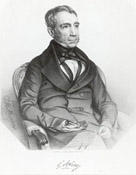The Airy Transit Circle

George Biddell Airy was Astronomer Royal at the Royal Observatory in Greenwich from 1835 to 1881. In his time, Airy transformed the observatory, installing some of the most advanced astronomical apparatus of his day and expanding both staff numbers and their workload. Staff had to clock-in and clock-out - common practice in Victorian factories and he also introduced new methods for dealing with the larger scale of the organisation. Further steps to automate systems and the production of strict step-by-step guidelines, all helped to reduce human error and increase efficiency.
The Airy Transit Circle, installed in 1850 and first used on 4th January 1851 is emblematic of the revolution in working practice introduced by Airy at the Royal Observatory. It sits on the north-south line, which today marks longitude 0°. This Prime Meridian, signals the start of the Universal day for the entire world. At the time of its installation, the Airy Transit Circle marked a huge advance on existing technology.
A transit instrument is always lined up with a north-south line, or meridian. When a star passes over the meridian, the transit instrument can be used to measure the angle at which this happens. Whilst this happens, an extremely accurate clock, called a regulator, is used to measure the time it occurs. These two measurements give the co-ordinates of that star, which can be used to make a star chart - and star position tables to aid navigation. The production of these tables, published annually to this day in the Nautical Almanac, was fundamental to the founding duty of the Observatory, which was to improve navigation.

0 Comments:
Post a Comment
<< Home